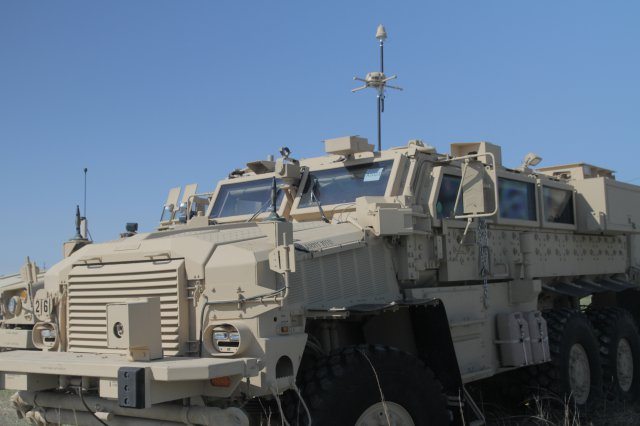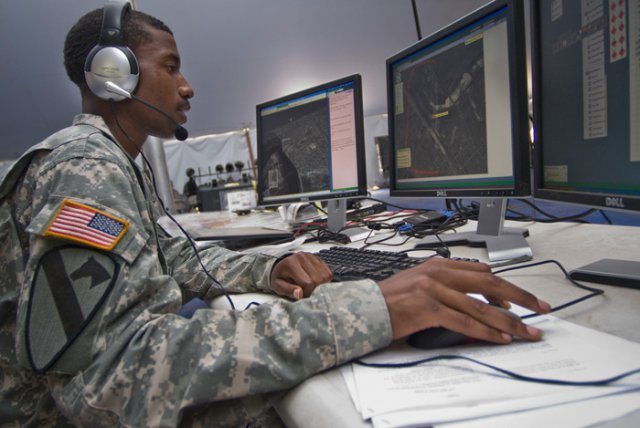Creating a picture of the battlefield so that commanders can make informed decisions on how to operate encompasses various forms of intelligence. With the delivery of the first Prophet Enhanced (program of record) to the 504th Battlefield Surveillance Brigade the realm of ground signals intelligence received a major boost.
Prophet Enhanced serves as the Army’s premier ground signals intelligence, or SIGINT, platform, building upon the success and lessons learned from preceding Prophet Systems including: Prophet Spiral 1, Triton III and a quick reaction capability, or QRC, version of Prophet Enhanced.
With the initial fielding of eight systems to the 504th Battlefield Surveillance Brigade, or BSB, a major milestone for military intelligence Soldiers was reached as they took possession of a more survivable, flexible and easy to use system that greatly enhances their ability to perform ground signals intelligence missions.
“Prophet supports the ISR (intelligence surveillance reconnaissance) mission particularly in the areas of persistent area analysis, situational development and mission overwatch by providing actionable intelligence to commanders to execute their missions,” said Lt. Col. Jim Ross, product manager for Prophet.
The effective use of Prophet Enhanced systems will allow Soldiers and teams to provide much needed situational awareness to Joint Forces and Commanders at levels that weren’t achievable just a few years ago. Information obtained using the Prophet systems will be invaluable in the ongoing operations in Afghanistan or during any other mission where they may be needed.
The main difference between the QRC version and the program of record version of Prophet lies in the fact that the latter gives a great deal of flexibility to commanders in terms of modular components.
“The QRC version required full integration on to specific platforms which limited flexibility in using components away from the vehicle or in a dismounted capacity. What we have done with the program of record version was modularize the components so that they could be quickly integrated on to, and removed from, the vehicle,” said Ross.
Prophet Enhanced is also equipped with the latest SIGINT enterprise software tools, optimized for the system in what is referred to as the Prophet Software Suite, or PS2. The prospect of operating with the most cutting edge technology has been eagerly awaited for by the Soldiers assigned to utilize Prophet systems.
“As an MI (military intelligence) Soldier, the Prophet Enhanced is a very welcome addition as it offers crucial upgrades and software changes that have improved the overall integration of system components,” said Chief Warrant Officer 2 Shane Harman, 504th BSB SIGINT advisor.
In describing the role Prophet Enhanced plays in the mission of an MI Soldier, Harman pointed out, “The new Prophet Enhanced gives our forces a more robust operational capability as it allows for easier movement of the dismount system. Additionally, by increasing the number of communications platforms, operators are afforded added flexibility to potentially conduct simultaneous split based, fixed and mobile operations.”
Prophet Enhanced is installed onto Panther variants of the mine-resistant, ambush-protected, or MRAP, which is a large six-wheeled, v-hulled vehicle that offers passengers added protection from improvised explosive devices, as well as greater operating space.
Additionally, the Department of the Army provided PM Prophet with one MRAP all-terrain vehicle, or MATV, to outfit with Prophet which had been demonstrated to the 504th with positive reviews due to the additional mobility the vehicle could provide in austere conditions.
“Some units have indicated they may submit operational needs statements to move out on MATV variants,” said Ross.
Allowing Soldiers to operate away from the sensor has direct benefits in Soldier Safety as well as efficiency.
“The sensor can be placed in a location (outside the wire) and the Soldier can have the ability to operate in a safe enclave among other Intel Soldiers from the other intelligence components,” noted Ross.
“Now, when a Soldier collects SIGINT, it can be in a distributed fashion where they collaborate with one another and they are able to evaluate, collect and exploit the information collected by the sensors in that enclave rather than having to be right where the sensor is and having to go back and load the information,” Ross explained. “We have allowed for distributed operations and have allowed for them to operate in a collaborative and safe environment, dismounted while the mounted piece is still out.”
Ultimately the product manager office anticipates fielding up to 50 sensors to the rest of the Army during the next several fiscal years.











